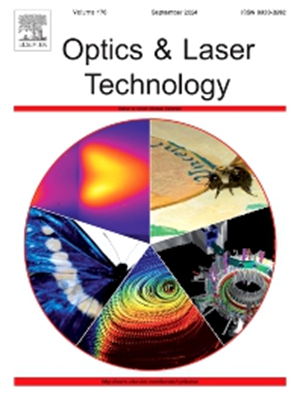1876 nm的纳焦耳能级、保偏、耗散孤子锁模铥光纤激光器
IF 4.6
2区 物理与天体物理
Q1 OPTICS
引用次数: 0
摘要
我们报道了一种环境健壮、耗散孤子、锁模的掺铥光纤激光器,使用全保偏(all-PM)光纤,工作在1876 nm的短波红外区域。自启动,模式锁定操作是由单壁碳纳米管(SWNT)为基础的饱和吸收剂(SA)。通过使用市售的PM色散补偿光纤(DCF)来管理腔色散。PM光纤Lyot滤波器使耗散孤子模式锁定在1876 nm的中心波长。激光器产生稳定的脉冲,重复频率为~ 19.2 MHz,平均功率为~ 21.5 mW,对应于脉冲能量~ 1.1 nJ。输出脉冲的持续时间为4.2 ps,可以使用基于光栅的压缩器压缩到391 fs。通过改变净腔色散,可以在566 fs的压缩脉冲宽度下获得更高的脉冲能量~ 3.2 nJ。据我们所知,这是第一个基于SWNT的nj能级、全光纤化PM耗散孤子锁模tm掺杂光纤激光器,在高穿透非线性生物医学成像显微镜中具有应用潜力。本文章由计算机程序翻译,如有差异,请以英文原文为准。
Nanojoule-energy-level, polarization-maintaining, dissipative-soliton mode-locked thulium fiber laser at 1876 nm
We report an environmentally robust, dissipative-soliton, mode-locked Tm-doped fiber laser operating in the short-wavelength infrared region at 1876 nm, using all-polarization-maintaining (all-PM) fibers. Self-starting, mode-locked operation is enabled by a single-wall carbon nanotube (SWNT) based saturable absorber (SA). Cavity dispersion is managed by using a commercially available PM dispersion compensating fiber (DCF). A PM fiber Lyot filter enables dissipative-soliton mode locking at a central wavelength of 1876 nm. The laser generates stable pulses at a repetition rate ∼ 19.2 MHz with an average power ∼ 21.5 mW, corresponding to a pulse energy ∼ 1.1 nJ. The output pulse has a duration of 4.2 ps and can be compressed down to 391 fs using a grating-based compressor. A higher pulse energy ∼ 3.2 nJ can be obtained with a compressed pulse width of 566 fs by varying the net cavity dispersion. To the best of our knowledge, this is the first nJ-energy-level, all-fiberized PM dissipative-soliton mode-locked Tm-doped fiber laser based on SWNT, with potential for applications in high-penetration nonlinear biomedical imaging microscopy.
求助全文
通过发布文献求助,成功后即可免费获取论文全文。
去求助
来源期刊
CiteScore
8.50
自引率
10.00%
发文量
1060
审稿时长
3.4 months
期刊介绍:
Optics & Laser Technology aims to provide a vehicle for the publication of a broad range of high quality research and review papers in those fields of scientific and engineering research appertaining to the development and application of the technology of optics and lasers. Papers describing original work in these areas are submitted to rigorous refereeing prior to acceptance for publication.
The scope of Optics & Laser Technology encompasses, but is not restricted to, the following areas:
•development in all types of lasers
•developments in optoelectronic devices and photonics
•developments in new photonics and optical concepts
•developments in conventional optics, optical instruments and components
•techniques of optical metrology, including interferometry and optical fibre sensors
•LIDAR and other non-contact optical measurement techniques, including optical methods in heat and fluid flow
•applications of lasers to materials processing, optical NDT display (including holography) and optical communication
•research and development in the field of laser safety including studies of hazards resulting from the applications of lasers (laser safety, hazards of laser fume)
•developments in optical computing and optical information processing
•developments in new optical materials
•developments in new optical characterization methods and techniques
•developments in quantum optics
•developments in light assisted micro and nanofabrication methods and techniques
•developments in nanophotonics and biophotonics
•developments in imaging processing and systems

 求助内容:
求助内容: 应助结果提醒方式:
应助结果提醒方式:


